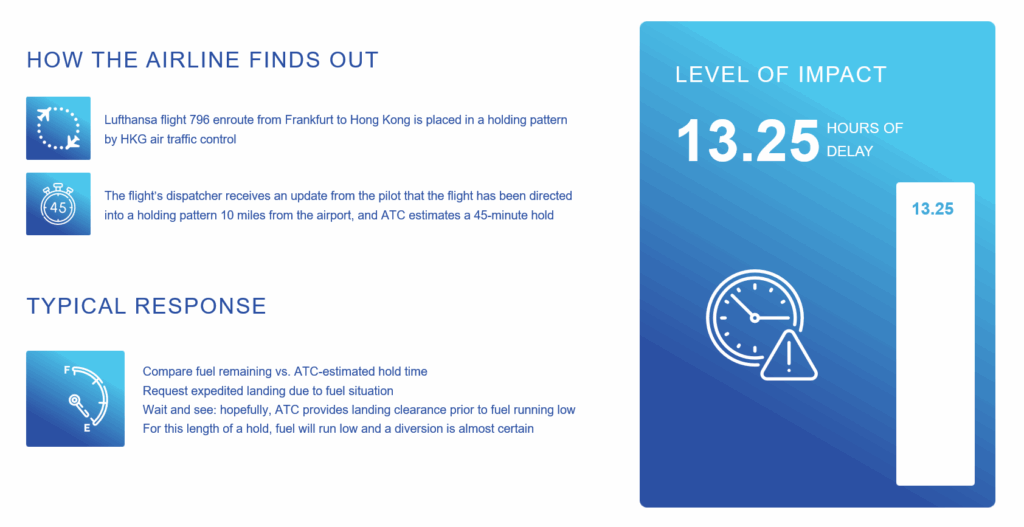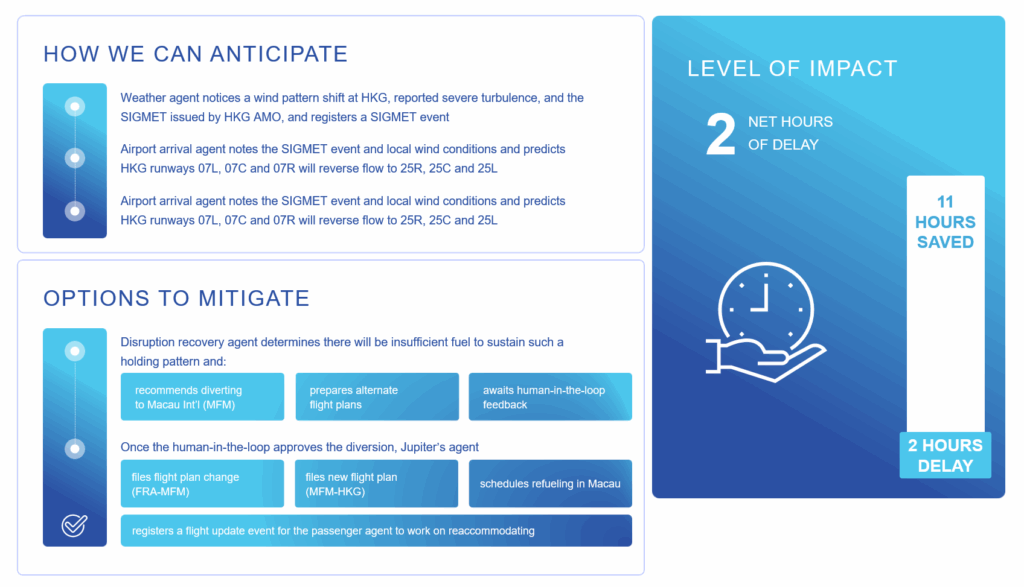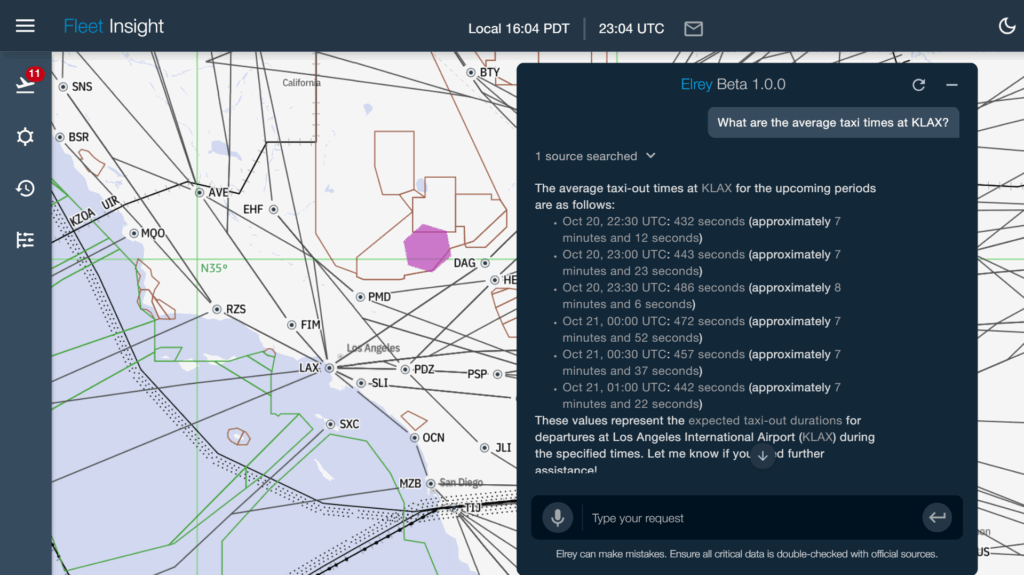
Putting Flight Disruption Back in its Place: Introducing Stratosphere
Aviation is a choreography of variables: shifting weather, airport constraints, airspace reroutes, crew legality, maintenance surprises, and the continuing pressure of time. And ironically, as air traffic proliferates and continues to advance, more expectations are created. Now, operations teams are stretched thin, and more hiring isn’t the fastest nor most effective fix.
One improving factor is that all these variables can now generate tremendous amounts of data. How varying tools exploit that data – if at all – is crucial to staying ahead, staying safe, and creating satisfied customers. Artificial intelligence (AI), used responsibly, can turn that data into foresight.
At Jeppesen, we’re incorporating AI intelligence across the spectrum of our products to help operators get the most use of this data and make real-time informed decisions. This transformative process has resulted in a platform we call Stratosphere.
Stratosphere provides solutions to unforeseen aviation challenges, sharpening human judgment rather than replacing it. It is seamlessly integrated with Jeppesen-Foreflight products, and it leverages AI and other advanced technologies to help airline operators and pilots make informed, real-time decisions. It is built and continuously refined using over 90 years of aviation data, incorporating both public and proprietary sources.
The reality of reactive disruption management
Airlines today often respond to major operational disruptions reactively: crews wait for updated air traffic control (ATC) instructions, dispatchers scramble to assess fuel and alternates, and passengers and schedules suffer cascading delays. But what if the response could be anticipatory, coordinated, and partly automated? So that a single weather change triggers a chain of protective actions across flight operations, crew management, and passenger care?

Imagine a hypothetical scenario — drawn from real operational patterns and used here for illustration: an inbound long-haul flight from Frankfurt, at capacity, is approaching Hong Kong International (HKG) for landing. The Hong Kong Observatory’s Airport Meteorological Office issues a SIGMET for severe turbulence near the airport, and ATC directs the aircraft to remain in a holding pattern. The pilot reports the hold to the dispatcher and ATC estimates a 45-minute delay.
Under current processes, the airline compares remaining fuel against ATC’s estimate, requests priority landing if needed, and then waits. For long holds, the likely outcome is a diversion—an expensive, disruptive sequence that could cascade into more than 13 hours of delay and significant recovery work. This type of disruption hits operations hard: crews are pushed to the limit, schedules are shattered, and passengers end up angry and frustrated.
Looking forward: A proactive approach with AI
Let’s look at this same example, but with the use of Stratosphere and it’s intelligent, embedded agents:
With the inbound flight approach HKG, Stratosphere’s weather agent automatically detects a wind-pattern shift and registers the SIGMET. The airport-arrival agent correlates local winds with runway operations and forecasts that HKG’s runways will reverse flow—from approaches on 07L/07C/07R to 25R/25C/25L—creating conditions likely to produce longer-than-normal holds.
Stratosphere’s delay-prediction agent ingests that forecast, compares it to prior events, and predicts a 60-minute hold for this flight—longer than ATC’s initial estimate and long enough to compromise the aircraft’s fuel reserves.
Recognizing the fuel risk and cascading impacts, Stratosphere’s disruption-recovery agent evaluates mitigation options and determines the most efficient operational response: divert straight to Macau International (MFM). The agent prepares alternate flight plans, estimates fuel and ground handling needs, and highlights the benefits of locking in the nearest suitable alternate immediately — thus, avoiding the hold and an ad-hoc diversion later that would add many hours of delay.
A human-in-the-loop (OCC dispatcher or operations manager) reviews and approves the recommended diversion. Once approved, Stratosphere executes the coordinated recovery actions: it files the flight-plan change (FRA→MFM), files the subsequent plan back to HKG (MFM→HKG), schedules refueling at Macau, and registers a flight-update event for passenger-accommodation workflows. Those downstream systems—passenger re-accommodation, OCC staffing, crew scheduling, and crew fatigue monitoring—immediately begin working in parallel, before any critical time is wasted.
Tangible benefits in a disruptive environment
In this scenario, diverting directly to Macau produces a net outcome of just two hours of delay for the flight. This avoids the estimated 13 hours of delay that would otherwise result from a late diversion and longer recovery cycle.
Stratosphere’s anticipatory actions save roughly 11 hours by averting the hold and streamlining ground handling (for example, pre-ordering fuel), while also reducing disruption to passengers. This outcome also limits crew duty and fatigue exposures and enables more efficient OCC staffing and re-accommodation strategies.
Beyond this one, specific example, the promise of Stratosphere is broader: AI-driven, event-aware, intelligent agents operating across weather monitoring, arrival forecasting, delay prediction, and recovery orchestration, can move airlines from reactive firefighting to proactive disruption management. By detecting signals early, recommending best alternates, preparing flight and ground plans, and integrating a human decision-maker into a rapid approval loop, airlines can realize significant operational efficiencies, cost savings, and improved passenger experience—turning potential chaos into coordinated, predictable outcomes. Simply put, Stratosphere predicts and remedies disruptions to create the most efficient outcome for everyone.
Stratosphere’s disruption example shows how anticipatory agents turn emerging signals into coordinated action. Now that we’ve illustrated the operational flow, let’s look under the hood at the data, pipelines, integrations, and models that make those outcomes possible.
Using the Right Data at the Right Time
Stratosphere aggregates and prioritizes the right information at the right time in any scenario, so teams can act fast, giving airline operators and pilots the ability to use data from all relevant systems. It delivers rapid access to aviation expertise and removes the burden of manually collecting fragmented information across disparate tools.
Stratosphere solves real operational pain points, addressing unforeseen challenges while sharpening — not replacing — human judgment. Integrated with Jeppesen and ForeFlight products, it leverages AI and other advanced technologies to give operators and pilots clear, timely decision support.
Built on more than 90 years of aviation expertise and data — including both public and proprietary sources — Stratosphere optimizes operations while aligning with aviation regulations and safety standards.
Core Data Streams Provide Real-Time Insights
Stratosphere aggregates and analyzes three core data streams:
- Public sources,
- Proprietary Jeppesen data; and
- Airline-specific data.
This unified dataset is the foundation for fast, confident decisions — delivered in context.
With live weather, air-traffic information, regulatory data, and airline-specific inputs all in one place, teams gain the real-time insights needed to reduce planning time and expedite operational adjustments.
From those core data streams, Stratosphere ingests and analyzes massive volumes of historical and live data — from weather and air-traffic congestion to airport- and aircraft-specific constraints. By turning diverse inputs into precise, prioritized guidance, the platform helps teams reduce delays, contain costs, and maintain compliance under pressure.
Built for Interoperability
Integration between various tools and systems is the key for accuracy and success. Stratosphere is designed to integrate seamlessly with existing aviation management systems, including fleet management, flight planning, and operations control software. And since it’s built and deployed in the cloud, the platform is modular and scalable. It’s also accessible to agents and systems via APIs and to humans through simple natural-language text or voice prompts.
Stratosphere lets airlines extend current systems with automation, advanced analytics, and decision support — all without overhauling the tech stack. The platform’s rapid deployment model gets airlines operational with their own data within weeks, shortening the path to measurable ROI and operational impact.
What Makes Stratosphere Different?
- Backed by 90 years of aviation expertise, Stratosphere combines three powerful data sources: publicly available aviation data, Boeing’s proprietary and curated navigation intelligence, and customer data.
- Powered by generative AI, Stratosphere enhances airline operations with real-time insights and recommendations – working within existing systems to support faster, smarter decisions.
- Integration with existing airline systems. Stratosphere will soon be available across all Jeppesen products.
Integrated with Jeppesen Products
We recently launched the beta version of Elrey, the Stratosphere front end, embedded within Jeppesen Fleet Insight.
Elrey supports dispatchers, flight followers, and operations teams when minutes count. Rendered inside the Fleet Insight UI, Elrey streamlines routine tasks, surfaces priorities in seconds, and assists — never replaces — human operators during critical decision windows. You can read more about Fleet Insight and Elrey here.
 Elrey (Stratosphere) embedded in the Jeppesen Fleet Insight UI
Elrey (Stratosphere) embedded in the Jeppesen Fleet Insight UI
This is the first of many upcoming integrations. Stratosphere will soon be integrated into additional Jeppesen-Foreflight products.
Beyond Disruption — Prediction and Simulation
It is important to keep in mind that disruption is just one of the many use cases where Stratosphere can sharpen human judgment. Of course, we see a lot of value in using the platform to address daily disruptions, but it is also equipped to help you with mid and long-term planning challenges. For example, the Airport Authority may decide to close a runway for a couple of weeks for re-carpeting, or they may decide to redesign the terminal airspace to accommodate growing flight volume.
Stratosphere incorporates predictive models that forecast the probability of certain outcomes given a set of conditions. Predictive models provide accurate inputs to flight-plan generation, and alerts for flight monitoring. Working along the predictive models is the simulation framework which provides business-rule engines and physics models that, given an input state, can determine a set of possible future states with probabilities assigned.
The simulation framework along with the predictive models will allow you to:
- Continuously integrate predictive models into the Stratosphere platform to proactively solve problems;
- Conduct what-if analysis; and
- Understand the implications of operational decisions.
A Continuous Improvement of Operational Performance
More than a technology stack, Stratosphere represents a shift in how airlines operate: faster decisions, fewer manual steps, and clearer priorities for frontline teams.
Combining AI with diverse data sources, Stratosphere boosts operational performance and safety, enhances the passenger experience, and helps airlines cut costs and increase resilience. As the industry evolves, it helps airlines compete more effectively and build stronger customer loyalty.
Get ready to optimize operations with Stratosphere — built for measurable performance and rapid results. Talk to our sales team to learn how Stratosphere integrates with your systems, what deployment looks like for your operations, and which KPIs improve first.
→ READ NEXT: Putting the Stratosphere Architecture to Work: Two Operational Scenarios
Aviation is a choreography of variables: shifting weather, airport constraints, airspace reroutes, crew legality, maintenance surprises, and the continuing pressure of time. And ironically, as air traffic proliferates and continues to advance, more expectations are created. Now, operations teams are stretched thin, and more hiring isn’t the fastest nor most effective fix.
One improving factor is that all these variables can now generate tremendous amounts of data. How varying tools exploit that data – if at all – is crucial to staying ahead, staying safe, and creating satisfied customers. Artificial intelligence (AI), used responsibly, can turn that data into foresight.
At Jeppesen, we’re incorporating AI intelligence across the spectrum of our products to help operators get the most use of this data and make real-time informed decisions. This transformative process has resulted in a platform we call Stratosphere.
Stratosphere provides solutions to unforeseen aviation challenges, sharpening human judgment rather than replacing it. It is seamlessly integrated with Jeppesen-Foreflight products, and it leverages AI and other advanced technologies to help airline operators and pilots make informed, real-time decisions. It is built and continuously refined using over 90 years of aviation data, incorporating both public and proprietary sources.
The reality of reactive disruption management
Airlines today often respond to major operational disruptions reactively: crews wait for updated air traffic control (ATC) instructions, dispatchers scramble to assess fuel and alternates, and passengers and schedules suffer cascading delays. But what if the response could be anticipatory, coordinated, and partly automated? So that a single weather change triggers a chain of protective actions across flight operations, crew management, and passenger care?

Imagine a hypothetical scenario — drawn from real operational patterns and used here for illustration: an inbound long-haul flight from Frankfurt, at capacity, is approaching Hong Kong International (HKG) for landing. The Hong Kong Observatory’s Airport Meteorological Office issues a SIGMET for severe turbulence near the airport, and ATC directs the aircraft to remain in a holding pattern. The pilot reports the hold to the dispatcher and ATC estimates a 45-minute delay.
Under current processes, the airline compares remaining fuel against ATC’s estimate, requests priority landing if needed, and then waits. For long holds, the likely outcome is a diversion—an expensive, disruptive sequence that could cascade into more than 13 hours of delay and significant recovery work. This type of disruption hits operations hard: crews are pushed to the limit, schedules are shattered, and passengers end up angry and frustrated.
Looking forward: A proactive approach with AI
Let’s look at this same example, but with the use of Stratosphere and it’s intelligent, embedded agents:
With the inbound flight approach HKG, Stratosphere’s weather agent automatically detects a wind-pattern shift and registers the SIGMET. The airport-arrival agent correlates local winds with runway operations and forecasts that HKG’s runways will reverse flow—from approaches on 07L/07C/07R to 25R/25C/25L—creating conditions likely to produce longer-than-normal holds.
Stratosphere’s delay-prediction agent ingests that forecast, compares it to prior events, and predicts a 60-minute hold for this flight—longer than ATC’s initial estimate and long enough to compromise the aircraft’s fuel reserves.
Recognizing the fuel risk and cascading impacts, Stratosphere’s disruption-recovery agent evaluates mitigation options and determines the most efficient operational response: divert straight to Macau International (MFM). The agent prepares alternate flight plans, estimates fuel and ground handling needs, and highlights the benefits of locking in the nearest suitable alternate immediately — thus, avoiding the hold and an ad-hoc diversion later that would add many hours of delay.
A human-in-the-loop (OCC dispatcher or operations manager) reviews and approves the recommended diversion. Once approved, Stratosphere executes the coordinated recovery actions: it files the flight-plan change (FRA→MFM), files the subsequent plan back to HKG (MFM→HKG), schedules refueling at Macau, and registers a flight-update event for passenger-accommodation workflows. Those downstream systems—passenger re-accommodation, OCC staffing, crew scheduling, and crew fatigue monitoring—immediately begin working in parallel, before any critical time is wasted.
Tangible benefits in a disruptive environment
In this scenario, diverting directly to Macau produces a net outcome of just two hours of delay for the flight. This avoids the estimated 13 hours of delay that would otherwise result from a late diversion and longer recovery cycle.
Stratosphere’s anticipatory actions save roughly 11 hours by averting the hold and streamlining ground handling (for example, pre-ordering fuel), while also reducing disruption to passengers. This outcome also limits crew duty and fatigue exposures and enables more efficient OCC staffing and re-accommodation strategies.
Beyond this one, specific example, the promise of Stratosphere is broader: AI-driven, event-aware, intelligent agents operating across weather monitoring, arrival forecasting, delay prediction, and recovery orchestration, can move airlines from reactive firefighting to proactive disruption management. By detecting signals early, recommending best alternates, preparing flight and ground plans, and integrating a human decision-maker into a rapid approval loop, airlines can realize significant operational efficiencies, cost savings, and improved passenger experience—turning potential chaos into coordinated, predictable outcomes. Simply put, Stratosphere predicts and remedies disruptions to create the most efficient outcome for everyone.
Stratosphere’s disruption example shows how anticipatory agents turn emerging signals into coordinated action. Now that we’ve illustrated the operational flow, let’s look under the hood at the data, pipelines, integrations, and models that make those outcomes possible.
Using the Right Data at the Right Time
Stratosphere aggregates and prioritizes the right information at the right time in any scenario, so teams can act fast, giving airline operators and pilots the ability to use data from all relevant systems. It delivers rapid access to aviation expertise and removes the burden of manually collecting fragmented information across disparate tools.
Stratosphere solves real operational pain points, addressing unforeseen challenges while sharpening — not replacing — human judgment. Integrated with Jeppesen and ForeFlight products, it leverages AI and other advanced technologies to give operators and pilots clear, timely decision support.
Built on more than 90 years of aviation expertise and data — including both public and proprietary sources — Stratosphere optimizes operations while aligning with aviation regulations and safety standards.
Core Data Streams Provide Real-Time Insights
Stratosphere aggregates and analyzes three core data streams:
- Public sources,
- Proprietary Jeppesen data; and
- Airline-specific data.
This unified dataset is the foundation for fast, confident decisions — delivered in context.
With live weather, air-traffic information, regulatory data, and airline-specific inputs all in one place, teams gain the real-time insights needed to reduce planning time and expedite operational adjustments.
From those core data streams, Stratosphere ingests and analyzes massive volumes of historical and live data — from weather and air-traffic congestion to airport- and aircraft-specific constraints. By turning diverse inputs into precise, prioritized guidance, the platform helps teams reduce delays, contain costs, and maintain compliance under pressure.
Built for Interoperability
Integration between various tools and systems is the key for accuracy and success. Stratosphere is designed to integrate seamlessly with existing aviation management systems, including fleet management, flight planning, and operations control software. And since it’s built and deployed in the cloud, the platform is modular and scalable. It’s also accessible to agents and systems via APIs and to humans through simple natural-language text or voice prompts.
Stratosphere lets airlines extend current systems with automation, advanced analytics, and decision support — all without overhauling the tech stack. The platform’s rapid deployment model gets airlines operational with their own data within weeks, shortening the path to measurable ROI and operational impact.
What Makes Stratosphere Different?
- Backed by 90 years of aviation expertise, Stratosphere combines three powerful data sources: publicly available aviation data, Boeing’s proprietary and curated navigation intelligence, and customer data.
- Powered by generative AI, Stratosphere enhances airline operations with real-time insights and recommendations – working within existing systems to support faster, smarter decisions.
- Integration with existing airline systems. Stratosphere will soon be available across all Jeppesen products.
Integrated with Jeppesen Products
We recently launched the beta version of Elrey, the Stratosphere front end, embedded within Jeppesen Fleet Insight.
Elrey supports dispatchers, flight followers, and operations teams when minutes count. Rendered inside the Fleet Insight UI, Elrey streamlines routine tasks, surfaces priorities in seconds, and assists — never replaces — human operators during critical decision windows. You can read more about Fleet Insight and Elrey here.
 Elrey (Stratosphere) embedded in the Jeppesen Fleet Insight UI
Elrey (Stratosphere) embedded in the Jeppesen Fleet Insight UI
This is the first of many upcoming integrations. Stratosphere will soon be integrated into additional Jeppesen-Foreflight products.
Beyond Disruption — Prediction and Simulation
It is important to keep in mind that disruption is just one of the many use cases where Stratosphere can sharpen human judgment. Of course, we see a lot of value in using the platform to address daily disruptions, but it is also equipped to help you with mid and long-term planning challenges. For example, the Airport Authority may decide to close a runway for a couple of weeks for re-carpeting, or they may decide to redesign the terminal airspace to accommodate growing flight volume.
Stratosphere incorporates predictive models that forecast the probability of certain outcomes given a set of conditions. Predictive models provide accurate inputs to flight-plan generation, and alerts for flight monitoring. Working along the predictive models is the simulation framework which provides business-rule engines and physics models that, given an input state, can determine a set of possible future states with probabilities assigned.
The simulation framework along with the predictive models will allow you to:
- Continuously integrate predictive models into the Stratosphere platform to proactively solve problems;
- Conduct what-if analysis; and
- Understand the implications of operational decisions.
A Continuous Improvement of Operational Performance
More than a technology stack, Stratosphere represents a shift in how airlines operate: faster decisions, fewer manual steps, and clearer priorities for frontline teams.
Combining AI with diverse data sources, Stratosphere boosts operational performance and safety, enhances the passenger experience, and helps airlines cut costs and increase resilience. As the industry evolves, it helps airlines compete more effectively and build stronger customer loyalty.
Get ready to optimize operations with Stratosphere — built for measurable performance and rapid results. Talk to our sales team to learn how Stratosphere integrates with your systems, what deployment looks like for your operations, and which KPIs improve first.
→ READ NEXT: Putting the Stratosphere Architecture to Work: Two Operational Scenarios